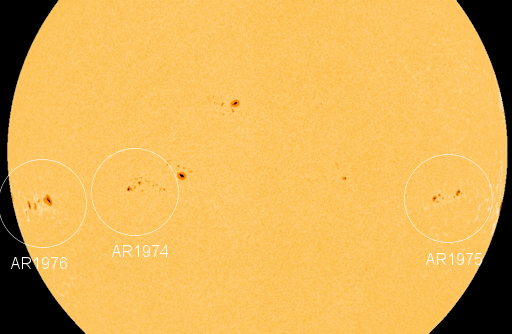JUPITER AND THE MOON: When the sun goes down tonight, step outside and look up. Jupiter and the gibbous Moon are only 5o apart--tight enough to fit inside the bowl of the Big Dipper. The bright conjunction is easy to see even from light-polluted cities. Take a look!
EMERGING SUNSPOTS: Over the weekend, active sunspots AR1967 and AR1968 rotated off the solar disk. However, the chance of flares has not decreased very much. Three new active regions have popped up to take their place:
The circled sunspots, AR1974 - AR1976, have 'beta-gamma' magnetic fields that harbor energy for medium-sized eruptions. And they are growing. NOAA forecasters estimate a 40% chance of M-class flares and a 5% chance of X-flares on Feb. 10th. Solar flare alerts: text, voice

Solar wind
speed: 468.8 km/sec
density: 1.9 protons/cm3
explanation | more data
Updated: Today at 1646 UT
X-ray Solar Flares
6-hr max: C2 1312 UT Feb10
24-hr: C3 0514 UT Feb10
explanation | more data
Updated: Today at: 1600 UT
![]()
Daily Sun: 10 Feb 14
Sunspots AR1974, AR1975 and AR1976 have 'beta-gamma' magnetic fields that harbor energy for M-class solar flares. Credit: SDO/HMI
![]()
Sunspot number: 180
What is the sunspot number?
Updated 10 Feb 2014
Spotless Days
Current Stretch: 0 days
2014 total: 0 days (0%)
2013 total: 0 days (0%)
2012 total: 0 days (0%)
2011 total: 2 days (<1%)
2010 total: 51 days (14%)
2009 total: 260 days (71%)
Update 10 Feb 2014
The Radio Sun
10.7 cm flux: 169 sfu
explanation | more data
Updated 10 Feb 2014
![]()
Current Auroral Oval:
Switch to: Europe, USA, New Zealand, Antarctica
Credit: NOAA/POES
![]()
Planetary K-index
Now: Kp= 1 quiet
24-hr max: Kp= 4 unsettled
explanation | more data
Interplanetary Mag. Field
Btotal: 5.2 nT
Bz: 2.6 nT north
explanation | more data
Updated: Today at 1646 UT
![]()
Coronal Holes: 10 Feb 14
There are no large coronal holes on the Earthside of the sun. Credit: SDO/AIA.





